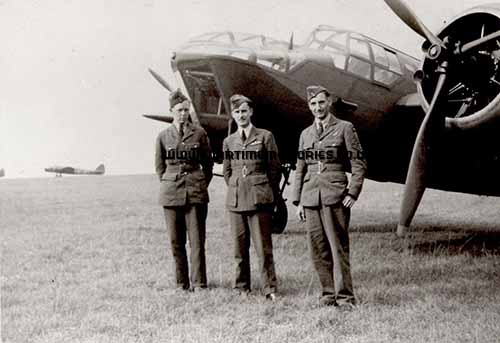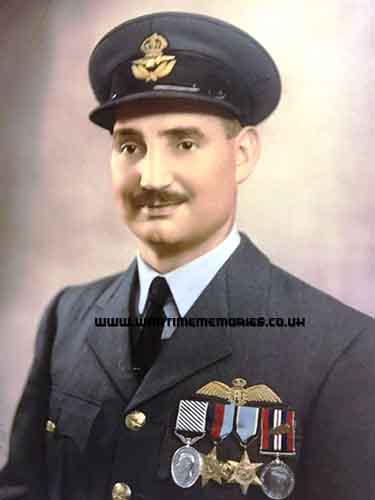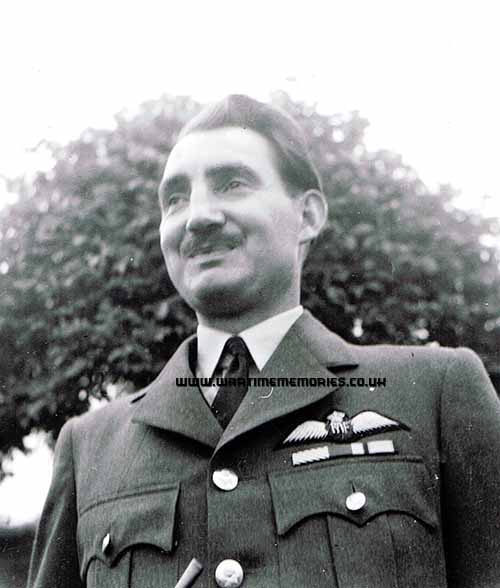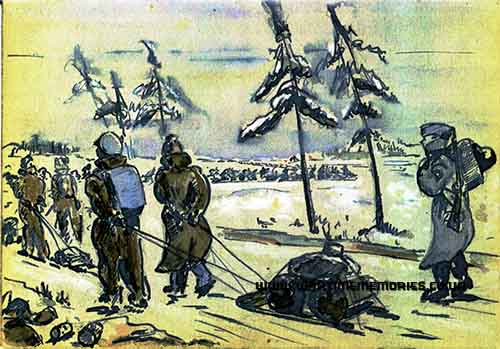Harold Bareham was commonly called Jack to his family and friends but "Bish" to his R.A.F. friends at Watton, he was my Father.
He joined the R.A.F. as an apprentice in 1930 and was a Navigator for the Earl of Bandon, with 82 Squadron serving out of R.A.F. Watton at outbreak of WWII in 1939. Having survived the heaviest losses where twice the whole squadron was lost. Once he had to turn back because of fuel guage problems and the second time he made it back having the whole perspex front blown off and all maps and charts lost. He left 82 Squadron in July 1940 being one of only 3 crew remaining who were there on 3rd September 1939. He was awarded the DFM for two citations earned at R.A.F. Watton as a Sergent Navigator.
Subsequently in 1941 Jack converted to Pilot and got his Wings having done a quick conversion on of all aircraft, The Blenheim! He then went on to fly Mosquitoes on the Ball-Bearing businessman run up to Scandinavia. Then in 1941 he volunteered to go back onto Ops and was transferred to Squadron 162 flying Hampdens.
He was shot down over Rotterdam in January 1942 after losing his tail and rear-gunner to flack! Ordering a bailout, the Naviator ended up in the sea and was drowned, the second pilot landed on the beach and Jack hit a house the town and slid down the snow on the rooftop and ended up in a snow drift. His war was over.
He spent 3.5 years in Stalag III and was a digger of the tunels in the Great Escape. Whilst he suffered 2 cave-ins during this process, he was numbered in the 200 due to escape, I believe number 143 or 147? After the cave-ins he was put in charge of "Soil distribution in the gardens" and a keen horticulturalist, the internees grew much produce under his stewardship!
He was instrumental in getting the first operational radio set operational in the camp and was responsible for semaphoring the "News from London" to the American Camp next door. Later they used an unscrewable cricket ball which he threw to a Mr Cody from California, as he had arrived at Stalag III at roughly the same time and they had made friends.
Jack spent time in the camp building a clock out of gramophone needles and cocoa tins! It took 18 months to build and kept better time than officer's Rolexes which they ordered and had delivered from Swizerland! The movement took 8 hours to wind down, and was wound up at lights out at 10pm and rewound before stopping at Revallie!
The weights were coffee tins and the pendulum a potato! It kept time within a minute every 3 weeks. it struck every hour on a bell from a pushbike! designed and built from tins and needles. The balanstaf was made from half a razorblade. On its first performance on Christmas Day 1943, the apparatus was suspended between two tables and it made its first continuous "tick-tock" to raputuous applause and thumping on the tabletop! Whereupon the whole thing colapsed into a heap of pieces and another 2 weeks work to reassemble for it to chime in the New Year on January 1st 1944.
When leaving the camp on the forced march in Febuary 1945, Jack was asked if he was taking his clock? He said to friends and collegues that a tin of Bully Beef was worth more to carry than an old clock! So it was wound up for the last time. Everyone in Jack's hut checked their Rolexes (If they had them) Saluted the clock and closed the door behind them. It was left for the Russians who liberated the camp to make of it as they would!?
Jack decided on the forced march, that whilst others might take tins of food with them from Red Cross Parcels, Jack would take little food but many tins of coffee and cigarettes with which he could trade for food and which were light on the sledge. It was February 1945 and the snow was thick on the ground. Carrying too much weight was a problem. Warm clothes were a must and Jack made a sledge from the back of a chair (as depicted in his painting) which was towed behind them. This Jack stacked high with coffee and cigarettes as useful currency at the time.
When arriving at a chateau from where they were liberated, a truck overtook them on the approach road to the castle, loaded with swedes. One fell off the back of the truck and was snapped up by a POW. That fellow POW was billetted with Jack and shared bunk beds, Jack on top. This POW shared the raw swede with Jack and both agreed it was the best food ever. That fellow POW who pocketed the swede that fell off the back of the lorry, was no other than Anthony Barber, the now Late Sir Anthony Barber, who became the Chancellor of the Exchequer in the 1970s.
After the war, Jack trained on Spitfires and then Vampires and Meteors, serving in UK and Germany. He rose to rank of Squadron Leader before retiring from the R.A.F. in 1953. He then joined B.O.A.C. in 1954, now British Airways as a Pilot Instructor. Firstly on Link Traniners, then Boeing 707 436s, then V.C.10s then back to Boeing 707 336s until his retirement in 1979 after 24 years service.
He died on 15th May 1992 aged 78 years, leaving a wife, a son, two daughters and three grandchildren.
I enclose a picture of the three surviving crew from one of the missions that suffered the worst mission casualty record of any R.A.F. Squadron during WWII having lost the whole squadron nearly twice over, and Jack's crew being the only crew to survive from beginning of WWII to July 1940.
I am in the process of putting together all documentation and his first hand recollections as well as stories he told both to my late mother and myself, regarding his life's work. I will make available a copy for anyone who wants it for historical research purposes only and not for commercial gain whatsoever!
There is much more than written here. However, in the late 1980s and 90s there was a museum set up at R.A.F. Watton to which my father contributed a substantial amount of memorabelia and photographs. The Museum closed in 1997/8 and since then I've not been able to trace the whereabouts of all the contents of the Museum. I believe a Mr Julian someone or other was running it, but what happened to him or the contents of the Museum including R.A.F. Watton's Role of Honour Wall-board, where my father's name and his D.F.M. are recorded, remains a mystery!!








